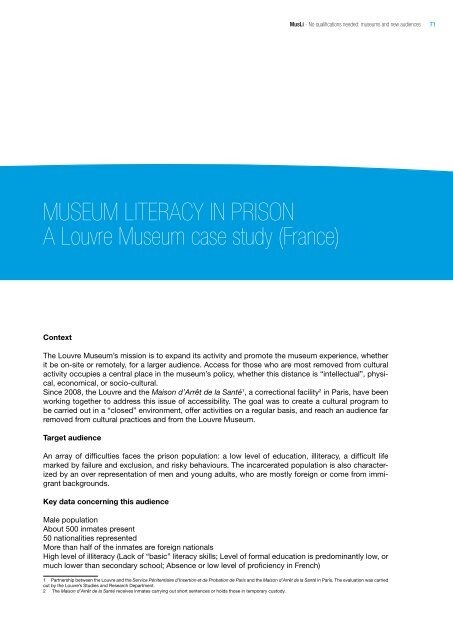MusLi (Museums Literacy) - Fondazione Fitzcarraldo
MusLi (Museums Literacy) - Fondazione Fitzcarraldo
MusLi (Museums Literacy) - Fondazione Fitzcarraldo
You also want an ePaper? Increase the reach of your titles
YUMPU automatically turns print PDFs into web optimized ePapers that Google loves.
MUSEUM LITERACY IN PRISON<br />
A Louvre Museum case study (France)<br />
Context<br />
<strong>MusLi</strong> - No qualifications needed: museums and new audiences<br />
The Louvre Museum’s mission is to expand its activity and promote the museum experience, whether<br />
it be on-site or remotely, for a larger audience. Access for those who are most removed from cultural<br />
activity occupies a central place in the museum’s policy, whether this distance is “intellectual”, physical,<br />
economical, or socio-cultural.<br />
Since 2008, the Louvre and the Maison d’Arrêt de la Santé 1 , a correctional facility 2 in Paris, have been<br />
working together to address this issue of accessibility. The goal was to create a cultural program to<br />
be carried out in a “closed” environment, offer activities on a regular basis, and reach an audience far<br />
removed from cultural practices and from the Louvre Museum.<br />
Target audience<br />
An array of difficulties faces the prison population: a low level of education, illiteracy, a difficult life<br />
marked by failure and exclusion, and risky behaviours. The incarcerated population is also characterized<br />
by an over representation of men and young adults, who are mostly foreign or come from immigrant<br />
backgrounds.<br />
Key data concerning this audience<br />
Male population<br />
About 500 inmates present<br />
50 nationalities represented<br />
More than half of the inmates are foreign nationals<br />
High level of illiteracy (Lack of “basic” literacy skills; Level of formal education is predominantly low, or<br />
much lower than secondary school; Absence or low level of proficiency in French)<br />
1 Partnership between the Louvre and the Service Pénitentiaire d’Insertion et de Probation de Paris and the Maison d’Arrêt de la Santé in Paris. The evaluation was carried<br />
out by the Louvre’s Studies and Research Department.<br />
2 The Maison d’Arrêt de la Santé receives inmates carrying out short sentences or holds those in temporary custody.<br />
71






